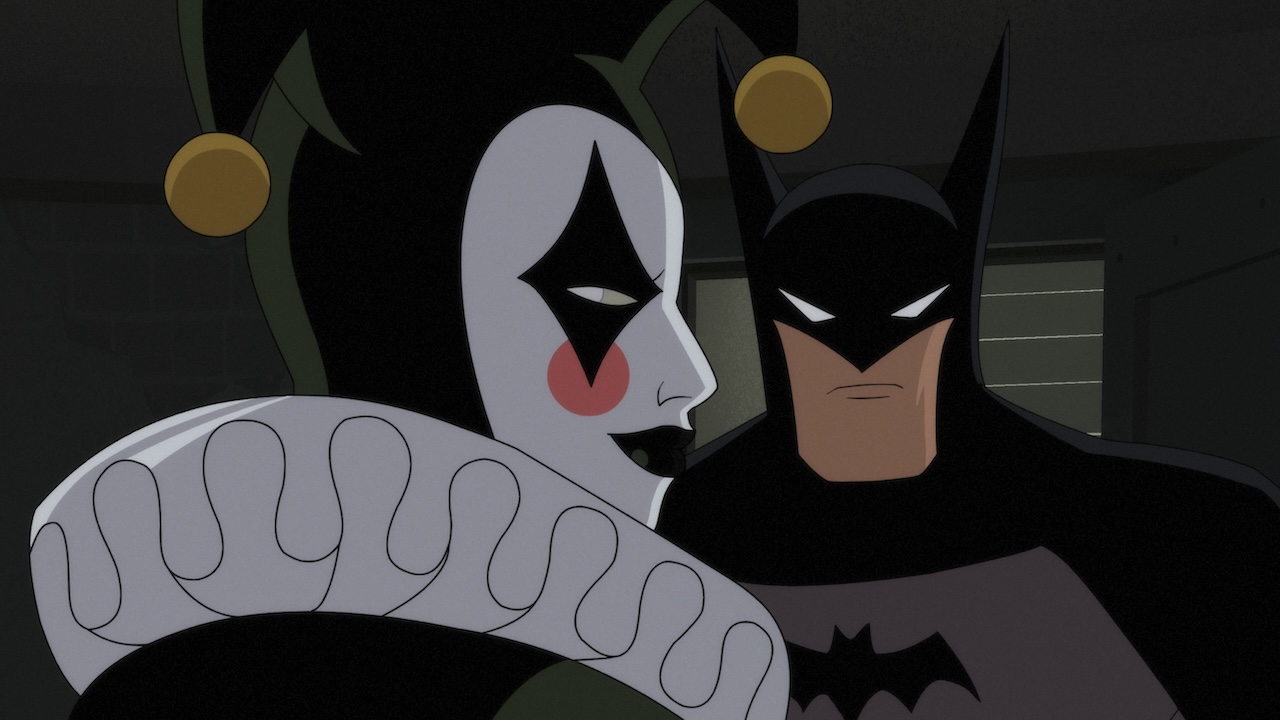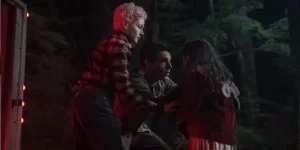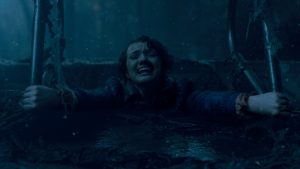
This Batman review contains spoilers.
Everything you need to know about Batman: Caped Crusader happens in the opening credits. Sepia-tone shots of Batman glowering from a rooftop or skulking through empty rooms give way to images of the Gotham police office and gangsters firing tommy guns, all set to a moody, mournful score. Fancy art-deco script introduces the creatives involved, including producer credits for J.J. Abrams and The Batman director Matt Reeves.
Then there’s Bruce Timm, whose influence on the series is unquestionable from the moment the credits scene kicks off. Caped Crusader plays like an updated version of the great Batman: The Animated Series, which Timm created with Eric Radomski. Male characters may not have the same barrel chests and female figures don’t all have hourglass shapes, but the same linework and designs from the ’90s show is present. Each frame appears painted on black matte paper again, while the animation remains fluid.
Like TAS, Caped Crusader puts character over plot. Most of the 10 season one episodes are standalone stories with a single case. “And Be a Villain” finds Batman investigating murders among actors, leading to the actor turned killer Basil Karlo aka Clayface (Dan Donohue). In “Night Ride,” Batman hunts down the Gentleman Ghost (Toby Stephens).
As those names might suggest, Caped Crusader goes for lesser-known entries in Batman’s rogues’ gallery, pulling deep for characters such as Nocturna (Mckenna Grace), Firebug (Tom Kenny), and Onomatopoeia (Reid Scott). The Penguin gets reimagined as devious female gangster Oswalda Cobblepot (Minnie Driver), her grotesque appearance taking a back seat to her general ruthlessness. Catwoman (Christina Ricci) becomes a spoiled party girl, while Deadshot and Killer Croc show up in small roles, both under their civilian names.
However, Caped Crusader does break the mold with two bigger-name villains, both of whom stretch across several episodes. Free from even a mention of the Joker, Harleen Quinzel (Jamie Chung) appears in several episodes as the psychologist best friend of Barbara Gordon (Krystal Joy Brown) and love interest for Detective Renee Montoya (Michelle C. Bonilla). Although certainly more energetic than any of her friends, Quinzel remains a thoughtful professional, a far cry from the spunky bombshell of most appearances. Radical methods drive her to create her Harley Quinn persona, for which Chung adopts a soft, frightening voice, pulling back Harley’s usual energy and turning her into something much more sinister.
The largest arc across the season deals with Harvey Dent, the District Attorney and Mayoral hopeful voiced by former Batman Diedrich Bader. Caped Crusader presents Harvey as a fundamentally good man who cares about justice, but succumbs to the occasional moral lapse, including accepting support from gangster Rupert Thorne (Cedric Yarbrough). As usual, Dent plays a counterpoint to Bruce, still in his early days as Batman, but the slow burn of his transition to Two-Face retains the tragedy of the oft-told story.
The Dent plot points to the other important name in the Caped Crusader credits, that of Ed Brubaker. In addition to writing standout arcs on Daredevil and Captain America for Marvel, Brubaker has a long history of excellent noir and crime comics, such as Gotham Central for DC and Reckless at Image.
Brubaker’s handle on pathetic criminals and corrupt heroes helps sell the noir trappings of Caped Crusader, giving a new mature edge to the TAS formula. In Caped Crusader, Harvey Bullock (John DiMaggio) and Arnold Flass (Gary Anthony Williams) have a killer edge, while Commissioner Gordon (Eric Morgan Stuart) allows his righteousness to become frightening. Caped Crusader‘s writers follow suit, telling stories in which people get shot or die, and characters regularly use harder language. Without going all the way, that is; the unfinished phrase “you son of a…” occurs often.
Caped Crusader‘s setting underscores its noir and hardboiled tales. Where TAS, like the Tim Burton-directed movies before it, took place in an art-deco place outside of time, Caped Crusader stays rooted in the 1940s. The timeline adds specificity to the series that distinguishes it from other Batman retellings. Batman wears a variation of the original suit that Bill Finger and Bob Kane debuted in 1939’s Detective Comics #27, and key parts of the mythology are missing, such as the Bat-Signal and the Bat-Computer.
That said, as a cartoon show, Caped Crusader can’t go all the way into the setting and genre. While changing the races of the Gordons, Quinzel, and Flass does add some welcome diversity to the cast, making the show’s Barbara Gordon the recipient of generational wealth in the early ’40s avoids a racist reality other noir stories would engage.
At this point, one might notice that a certain character hasn’t come up in this review. Yes, Batman and Bruce Wayne do appear in every episode of Caped Crusader, but he’s rarely the most interesting aspect. Part of the problem stems from Hamish Linklater’s vocal performance. At his best, Linklater echoes the work of Kevin Conroy in TAS. His Batman has a distinctive, but not ridiculous, growl and his Bruce Wayne is peppy and upbeat. But there’s also a flatness to Linklater’s voice work, especially when paired with professional voice actors, who know how to modulate their performances.
Caped Crusader doesn’t have much of an arc for Batman. The most significant drama involves Bruce’s relationship to Alfred (Jason Watkins), whom he usually refers to as just “Pennyworth.” There’s a bit there about Bruce coming to terms with his privilege, especially in relation to his contemporary Lucius Fox (Bumper Robinson), and wrestling with concepts of justice. But most often, Wayne or Batman just show up to do detective work, while the villains and side characters get the spotlight.
Is this a problem? Not really. As was often the case in early Batman and Detective Comics issues, Batman followed the story but did not drive it, and it’s a relief to see the Dark Knight Detective return to his gumshoe roots. The conflicts within Barbara Gordon and Harvey Dent provide more than enough drama to keep things interesting.
With only 10 episodes, it’s hard to say if Caped Crusader will become a classic like Batman: The Animated Series. But it’s off to a great start, following its hardboiled heart to become a unique entry to the Batman mythos.
All 10 episodes of Batman: Caped Crusader are streaming now on Prime Video.
Learn more about Den of Geek’s review process and why you can trust our recommendations here.
The post Batman: Caped Crusader Review: A More Mature Animated Series appeared first on Den of Geek.







